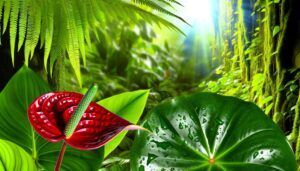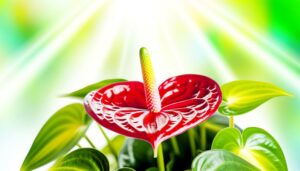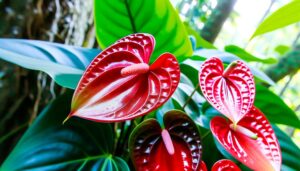Why Do Anthurium Leaves Turn Red?
Anthurium leaves turn red due to anthocyanin pigmentation, which is triggered by various factors. High-intensity light increases anthocyanin biosynthesis, providing photoprotection.
Temperature fluctuations, especially cold, induce pigment production as a defense mechanism. Overwatering causes root rot, while underwatering leads to cellular dehydration, both resulting in red leaves.
Nutrient deficiencies, particularly in phosphorus and potassium, alter leaf coloration. Monitoring soil moisture, light exposure, and maintaining stable temperatures are essential.
Anthocyanins also protect against oxidative stress from chemical exposure. To uncover more about maintaining best-suited conditions for Anthurium, consider exploring additional details.
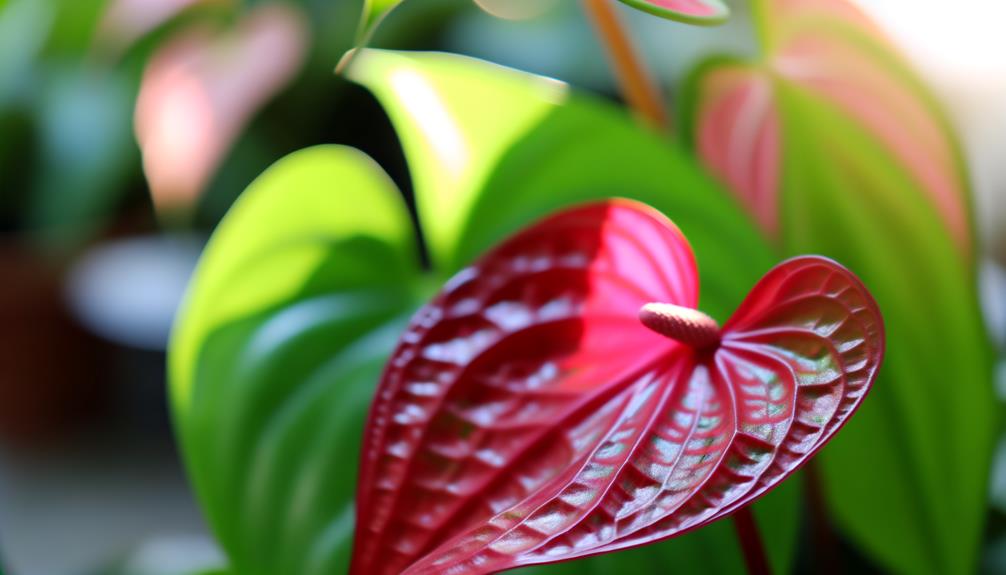
Key Takeaways
- Anthocyanin Pigmentation: Anthurium leaves turn red due to the accumulation of anthocyanin pigments, especially in young leaves and under stress.
- Light Exposure: High-intensity light triggers anthocyanin biosynthesis, leading to red pigmentation in Anthurium leaves.
- Temperature Fluctuations: Rapid temperature changes, especially cold temperatures, increase anthocyanin production as a protective mechanism.
- Watering Issues: Overwatering or underwatering disrupts nutrient uptake, causing red pigmentation in Anthurium leaves as a stress response.
- Nutrient Deficiency: Deficiencies in phosphorus and other nutrients lead to reddish-purple discoloration, starting from the leaf edges.
Natural Growth Process
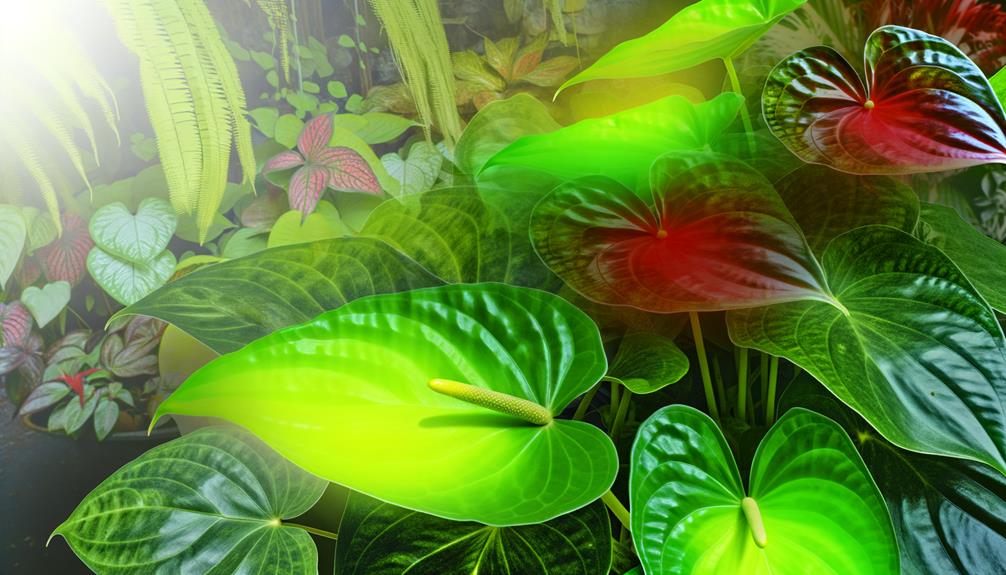
The reddening of Anthurium leaves during their natural growth process is often a result of anthocyanin pigmentation, which occurs as a protective response to various environmental stressors. You'll notice this phenolic compound accumulation primarily in young leaves or during stressful conditions like temperature fluctuations.
Anthocyanins play an essential role in photoprotection, mitigating oxidative stress by absorbing excess light and scavenging free radicals. This pigment not only acts as a sunscreen but also deters herbivores and pathogens, enhancing plant resilience. The biochemical pathways involved include the upregulation of flavonoid biosynthesis genes, driven by transcription factors responding to abiotic stress.
Understanding these mechanisms allows you to appreciate the intricate balance Anthurium maintains to thrive in dynamic environments.
Light Exposure
Light exposure greatly influences Anthurium leaf coloration by adjusting the synthesis of anthocyanins, which act as a protective mechanism against photodamage.
When your Anthurium is exposed to high-intensity light, it triggers the biosynthetic pathway for anthocyanins, resulting in red pigmentation. This chromatic shift is a photoprotective response, mitigating potential oxidative stress caused by excessive light.
Conversely, insufficient light can inhibit anthocyanin production, leading to greener leaves.
You should monitor the light intensity your plant receives, ensuring it's neither too strong nor too faint. Ideally, provide bright, indirect light to maintain peak pigmentation and overall health.
Temperature Changes
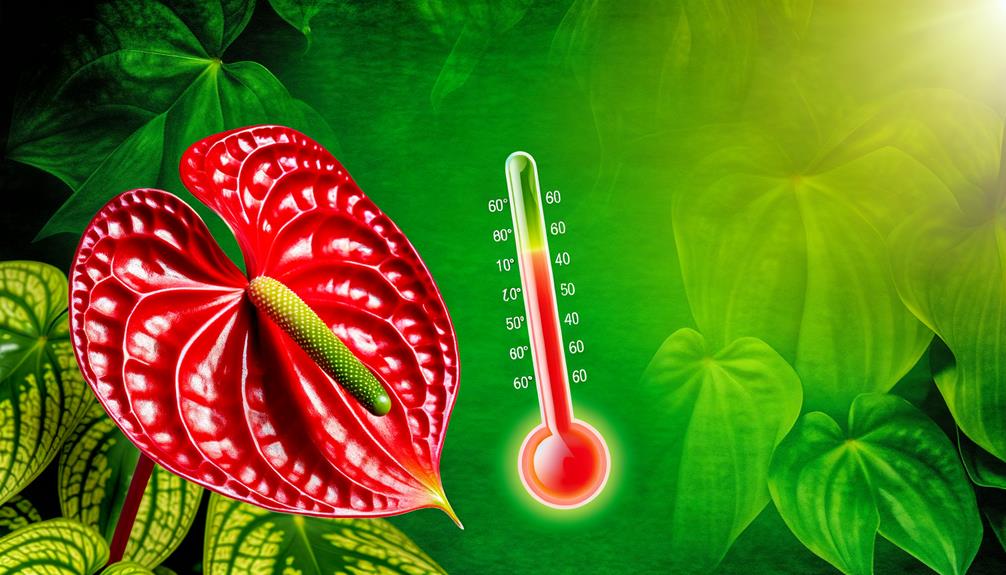
Rapid temperature fluctuations can have a notable impact on Anthurium leaf pigmentation by influencing cellular processes and stress responses. When temperatures drop suddenly, anthocyanin production can increase as a protective mechanism, causing leaves to turn red. This pigment acts as a shield, reducing oxidative stress and protecting chloroplasts from damage.
Conversely, high temperatures can induce heat shock proteins, potentially altering metabolic pathways and further impacting leaf coloration. You must monitor your Anthurium's environment closely, ensuring temperatures remain within the ideal range of 70-85°F (21-29°C). A stable thermal environment minimizes stress responses, thereby maintaining the plant's natural green pigmentation.
Watering Issues
When addressing watering issues, you'll need to take into account both overwatering and underwatering. Overwatering can lead to root rot, which disrupts nutrient uptake and manifests as red leaves due to stress responses.
Conversely, underwatering results in dehydration, causing anthocyanin accumulation that also turns leaves red.
Overwatering Concerns
Overwatering can lead to root rot in Anthurium, causing the leaves to turn red due to impaired nutrient uptake and oxygen deficiency at the root level. When you saturate the soil, it becomes waterlogged, reducing the soil's oxygen content and facilitating pathogenic fungi. These fungi attack the root system, leading to rot and subsequent nutrient transport failure.
Here's a quick reference table to elucidate the effects:
| Issue | Cause | Consequence |
|---|---|---|
| Root Rot | Overwatering | Red leaves, decay |
| Oxygen Deficiency | Saturated soil | Impaired root function |
| Pathogenic Fungi | Excess moisture | Root system infection |
| Nutrient Uptake | Blocked by rot | Leaf discoloration |
This intricately disrupts the plant's physiology, manifesting visibly through the crimson-hued foliage.
Underwatering Effects
Underwatering starves Anthurium roots of essential moisture, leading to cellular dehydration and subsequent red pigmentation in the leaves. When you neglect to provide sufficient water, the plant's vascular system struggles to maintain turgor pressure, vital for cell function and nutrient transport. This deficit triggers anthocyanin accumulation, a red pigment, as a stress response mechanism.
Moreover, prolonged dehydration disrupts photosynthesis, impairing chlorophyll synthesis and causing leaf discoloration. You'll notice the margins turning red first, a clear indicator of moisture deficiency.
Regularly monitor soil moisture content by inserting your finger an inch deep into the soil. If it feels dry, it's time to water. Consistent hydration will maintain cellular integrity, ensuring your Anthurium thrives with lush green foliage.
Nutrient Deficiency
You might observe your Anthurium's leaves turning red due to nutrient deficiencies. Specifically, a lack of iron can disrupt chlorophyll synthesis.
Phosphorus deficiency can impair energy transfer, and insufficient potassium levels can affect overall plant metabolism.
Addressing these deficiencies requires precise adjustments in your fertilization regimen to restore best nutrient balance.
Lack of Iron
A deficiency in iron, an essential micronutrient, can lead to chlorosis in anthurium leaves, causing them to turn red and display interveinal yellowing. Inadequate iron disrupts chlorophyll synthesis, vital for photosynthesis, leading to reduced energy production and impaired growth.
You'll notice young leaves exhibiting pronounced discoloration first, as iron is immobile within the plant. To diagnose, observe if the veins remain green while the surrounding tissue reddens and yellows.
Correcting this involves acidifying the soil to enhance iron availability or applying chelated iron directly. Monitor pH levels, as anthuriums thrive in slightly acidic conditions.
Phosphorus Deficiency Effects
Beyond iron deficiency, phosphorus deficiency represents another crucial nutrient imbalance that can cause anthurium leaves to turn red, manifesting as dark, reddish-purple discoloration starting from the leaf edges and progressing inward. Phosphorus is essential for energy transfer, photosynthesis, and nutrient movement within the plant. When it's lacking, anthocyanin pigments accumulate, resulting in the distinct reddish hue.
You'll notice stunted growth and delayed flower development as symptoms progress. Soil testing can confirm phosphorus levels, and applying a balanced, phosphorus-rich fertilizer can correct this deficiency. Maintain an optimal soil pH, ideally between 5.5 and 6.5, as phosphorus becomes less available in overly acidic or alkaline conditions.
Regular monitoring and balanced fertilization will keep your anthuriums healthy and vibrant.
Insufficient Potassium Levels
Insufficient potassium levels in anthurium plants can cause chlorosis, particularly around the leaf margins, leading to yellowing and subsequent necrosis. This deficiency disrupts the plant's photosynthetic efficiency, impairing carbohydrate metabolism and enzyme activation. As a result, the plant's overall vigor diminishes.
To diagnose and address potassium deficiency, consider the following:
- Soil Testing: Analyze soil nutrient content to determine potassium levels.
- Fertilization: Apply a balanced fertilizer rich in potassium to rectify the deficiency.
- Water Quality: Confirm irrigation water doesn't leach potassium from the soil.
- Leaf Tissue Analysis: Conduct a foliar analysis to confirm nutrient concentrations.
Pests and Diseases
Red discoloration in Anthurium leaves often indicates the presence of pests such as spider mites or diseases like bacterial blight. Spider mites feed on plant sap, causing cellular damage and subsequent red pigmentation due to stress. You'll notice fine webbing and stippled leaf surfaces.
Bacterial blight, caused by Xanthomonas, manifests as water-soaked lesions turning red or yellow. It's pivotal to isolate affected plants to prevent pathogen spread. Treat spider mites with miticides and increase humidity to deter their proliferation. For bacterial blight, prune infected leaves and apply copper-based bactericides.
Regularly inspect your Anthurium for signs of pests and diseases, maintaining optimal plant health through vigilant monitoring and prompt intervention. This guarantees your foliage remains vibrant and healthy.
Soil Quality

Best soil quality is crucial for Anthurium health, requiring a well-draining, loose, and aerated mix rich in organic matter. You should use a tailored substrate to maximize nutrient uptake and root development.
A high-quality soil mix should include the following components:
- Orchid Bark: Enhances aeration and drainage.
- Peat Moss: Retains moisture while providing acidity.
- Perlite: Increases soil porosity, promoting oxygen flow to roots.
- Activated Charcoal: Absorbs toxins, maintaining soil purity.
These components create an excellent environment for Anthuriums, preventing root rot and nutrient deficiencies that could lead to red leaves.
Humidity Levels
Maintaining ideal moisture levels is equally important for Anthurium plants, as insufficient moisture can lead to stress and red discoloration in the leaves. You need to make sure relative moisture levels remain between 60% and 80%.
When moisture drops, stomatal conductance decreases, leading to impaired photosynthesis and transpiration. This causes physiological stress, manifesting as red pigmentation due to anthocyanin accumulation.
Use a hygrometer to monitor ambient moisture closely. Employ humidifiers or pebble trays to maintain optimal conditions. Misting the leaves can provide temporary relief but should be done cautiously to avoid fungal infections.
Chemical Exposure
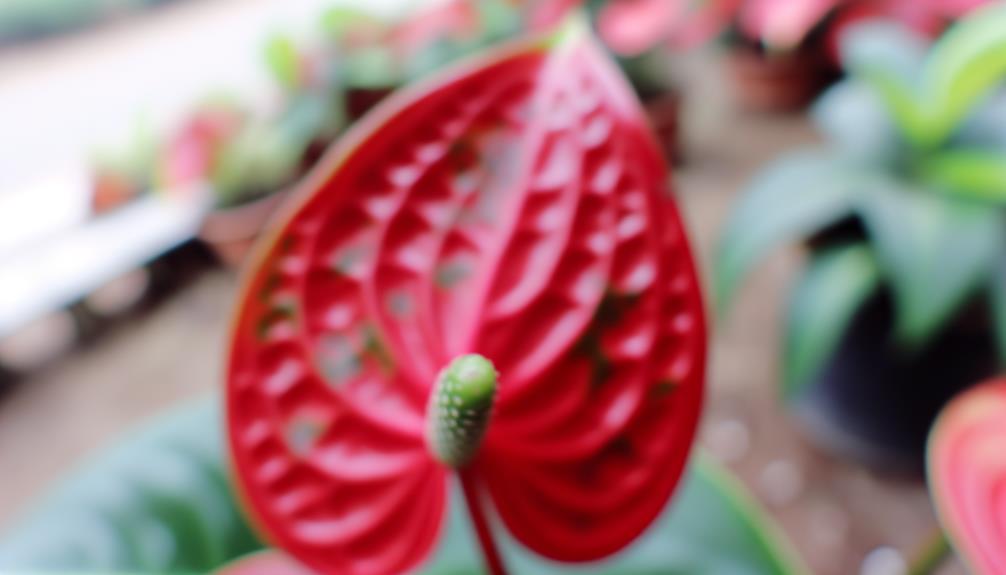
Exposure to chemicals, whether through pesticides, fertilizers, or household cleaners, can induce oxidative stress in Anthurium leaves, leading to red discoloration as a result of cellular damage and anthocyanin synthesis.
When you expose your Anthurium to these chemicals, they disrupt cellular homeostasis and trigger a defensive phytochemical response.
Here's what typically happens:
- Oxidative Stress: Reactive oxygen species (ROS) accumulate, damaging cellular components.
- Cellular Damage: Membrane lipids, proteins, and DNA suffer oxidative damage.
- Anthocyanin Synthesis: As a protective mechanism, the plant produces red anthocyanin pigments.
- Visual Symptoms: Leaves turn red, signaling distress and impaired photosynthetic efficiency.
Conclusion
As you explore further into the mysterious reasons behind your anthurium leaves turning red, you'll uncover a web of scientific complexities. Could it be irregular light exposure, or perhaps a subtle nutrient deficiency? Maybe it's the sneaky work of pests or a concealed chemical exposure?
Each factor intertwines, leading you closer to the truth. Yet, only through careful observation and accurate adjustments will you unravel the mystery and restore your anthurium's lush health.

